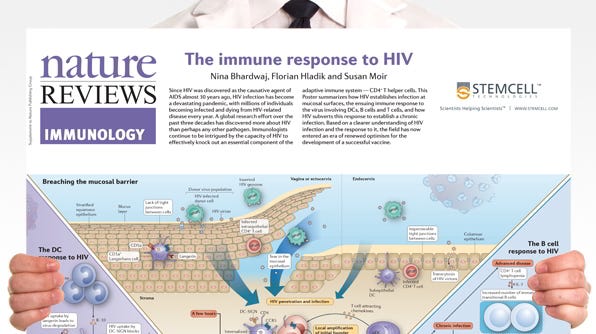Infectious Diseases and Immunology
Infectious diseases are caused by pathogens, including viruses and bacteria. Researchers aim to understand the interactions between these microorganisms and immune cells in order to develop vaccines and therapies against infectious diseases.
Below is a collection of scientific resources for your infectious disease research.
The Immune Response to HIV Poster
Nina Bhardwaj, Florian Hladik and Susan Moir. This Poster summarizes how HIV establishes infection at mucosal surfaces, the ensuing immune response to the virus involving DCs, B cells and T cells, and how HIV subverts this response to establish a chronic infection.
Get Your Free Copy >-
 Frequently Asked Questions on Primary CellsTechnical tip from our dedicated team of Product and Scientific Support specialists
Frequently Asked Questions on Primary CellsTechnical tip from our dedicated team of Product and Scientific Support specialists -
 SARS-CoV-2 Viral Diversity: Causes, Consequences, and OpportunitiesThe rapid spread of SARS-CoV-2 has been accompanied by the emergence of distinct viral clades, though their clinical significance remains unclear. In this webinar, Dr. Judd F. Hultquist discusses his recent data on how differences in virus genotype impact viral load and influence viral transmission and spread.
SARS-CoV-2 Viral Diversity: Causes, Consequences, and OpportunitiesThe rapid spread of SARS-CoV-2 has been accompanied by the emergence of distinct viral clades, though their clinical significance remains unclear. In this webinar, Dr. Judd F. Hultquist discusses his recent data on how differences in virus genotype impact viral load and influence viral transmission and spread. -
 How to Isolate Nucleated Cells from Whole Blood Using HetaSepÔäó Erythrocyte Aggregation AgentHetaSepÔäó is an erythrocyte aggregation agent used to quickly separate nucleated cells from red blood cells
How to Isolate Nucleated Cells from Whole Blood Using HetaSepÔäó Erythrocyte Aggregation AgentHetaSepÔäó is an erythrocyte aggregation agent used to quickly separate nucleated cells from red blood cells -
 Automate Cell Isolation with the RoboSepÔäó-S Cell Separation InstrumentStreamline your cell isolations using the fully automated RoboSepÔäó-S
Automate Cell Isolation with the RoboSepÔäó-S Cell Separation InstrumentStreamline your cell isolations using the fully automated RoboSepÔäó-S -
 Reducing Platelet Contamination in Blood SamplesPlatelets (thrombocytes), cell fragments derived from megakaryocytes, are used in normal blood clotting, and must be handled gently to prevent activation
Reducing Platelet Contamination in Blood SamplesPlatelets (thrombocytes), cell fragments derived from megakaryocytes, are used in normal blood clotting, and must be handled gently to prevent activation -
 Unloading the RoboSepÔäó-S CarouselBasic overview on how to use and maintain your RoboSepÔäó-S; steps to unload the instrument after a cell separation run has been completed
Unloading the RoboSepÔäó-S CarouselBasic overview on how to use and maintain your RoboSepÔäó-S; steps to unload the instrument after a cell separation run has been completed -
 How to Isolate PBMCs from Whole Blood Using Density Gradient Centrifugation (FicollÔäó or LymphoprepÔäó)This technical guide demonstrates how to isolate peripheral blood mononuclear cells from whole blood using density gradient centrifugation
How to Isolate PBMCs from Whole Blood Using Density Gradient Centrifugation (FicollÔäó or LymphoprepÔäó)This technical guide demonstrates how to isolate peripheral blood mononuclear cells from whole blood using density gradient centrifugation






